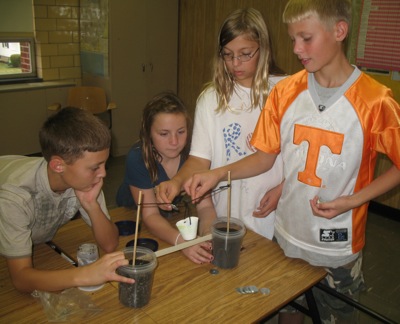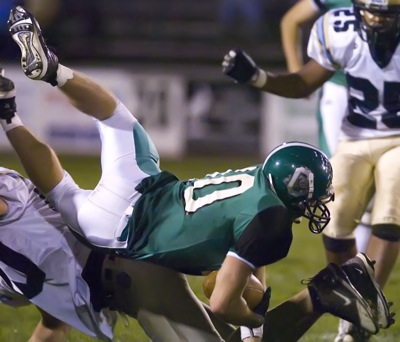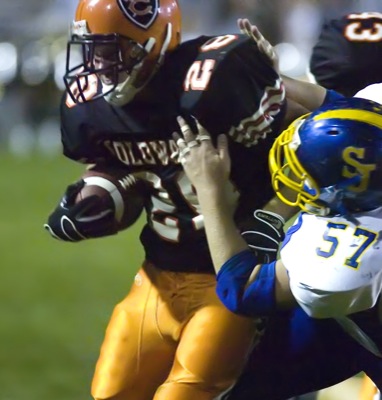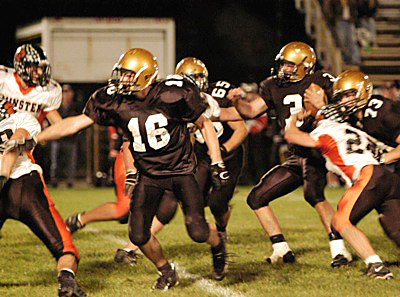Saturday, October 11th, 2008
Learning to bridge the gap
Students stretch skills to reach from New Bremen to Nepal
By Margie Wuebker

Photo by Margie Wuebker/The Daily Standard
Testing the strength of their TarPul or wire bridge are New Bremen Elementary School sixth graders Alex Britton, left, Danielle Ahlers, Adeline Whitten and Chris Albers. They have assumed the role of geotechnical engineers during a two-week Engineering is Elementary program.
NEW BREMEN - Students in Amy Poeppelman's sixth-grade science class are on a mission - a geotechnical engineering mission to be exact.
Their goal is to design a safe way for villagers in rural Nepal to safely reach a medical clinic situated across the river. The two-week lab unit, titled "A Stick in the Mud: Evaluating a Landscape," incorporates math, science and critical thinking components into an enjoyable exercise.
The story introduced students to Suman, a young villager, as well as the tools needed and challenges faced by geotechnical engineers in building a TarPul, or wire bridge, to provide a safe means of travel.
"My students first learned about foundations and how they are used to anchor structures particularly in earthquake-prone areas," Poeppelman says. "Unlike most science labs, students received no list of clearly defined directions to follow in order to come up with the end product."
Participants in the Engineering is an elementary program, funded through a collective grant to New Bremen, Fort Recovery and St. Henry schools by the Science, Technology, Engineering and Mathematics (STEM) Education Coalition, received all the necessary materials but had to rely on the five steps in the engineering design process (ask questions, imagine several solutions, plan your idea, create your idea and improve your idea) for direction on how to proceed.
According to the introductory story, villagers favored a sight near a bend in the river. Although located in close proximity to the village, the potential for damaging erosion was much greater. Students quickly discounted that site in favor of others after taking core samples and creating model sites incorporating layers of the earth's crust (bedrock, clay, sand and soil).
"It's really fun working with soil and models," sixth-grader Adeline Whitten says. "I learned soil with a lot of organic material is wimpy while rocky soil makes for a stronger foundation. And erosion often shows up in curvy areas along the river instead of on nice straight banks."
Fellow sixth-grader Alex Britton claims he's never had so much fun in science class, adding experimenting is far more interesting that listening to lectures.
"Sometimes a certain spot seemed like a real good place for the TarPul until I did an experiment," he says placing one of the wooden poles in non-compacted organic soil and watching as it slowly tilts toward the desk top. "See the poles stay in place in compacted rocky soil. They don't even sway as we add weights."
Chris Albers and Danielle Ahlers demonstrate the compaction process, pressing pebble-strewn soil with plastic beverage cups. The level of the soil in plastic kitchen containers gradually drops with pressure.
"We had eight possible TarPul sites," Whitten explains. "But the teams eliminated quite a few through experiments."
Each team must support its respective site selection step by step from beginning to end with winners determined on an assigned point basis.
Poeppelman, a 17-year teaching veteran, is nearly as excited about the program as her students. She has seen them accomplish far more than expected by thinking outside the box and being receptive to new ideas.
"Their performance is truly mind boggling," she says. "The story of the village is pure fiction but students are so involved they want to send their recommendations to people there. I guess we will send them off...somewhere."
Come spring the sixth graders will be rolling in dough - Play Dough that is - as they launch into a laboratory exercise called "A Work in Progress. Their mission will be to help a Canadian girl named Michelle develop a quality clay making process for her hockey teammates.




